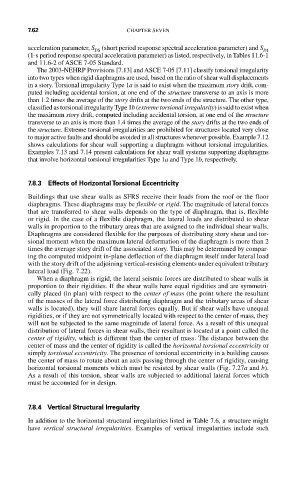Page 500 - Design of Reinforced Masonry Structures
P. 500
7.62 CHAPTER SEVEN
acceleration parameter, S (short period response spectral acceleration parameter) and S
D1
DS
(1-s period response spectral acceleration parameter) as listed, respectively, in Tables 11.6-1
and 11.6-2 of ASCE 7-05 Standard.
The 2003-NEHRP Provisions [7.13] and ASCE 7-05 [7.11] classify torsional irregularity
into two types when rigid diaphragms are used, based on the ratio of shear wall displacements
in a story. Torsional irregularity Type 1a is said to exist when the maximum story drift, com-
puted including accidental torsion, at one end of the structure transverse to an axis is more
than 1.2 times the average of the story drifts at the two ends of the structure. The other type,
classified as torsional irregularity Type 1b (extreme torsional irregularity) is said to exist when
the maximum story drift, computed including accidental torsion, at one end of the structure
transverse to an axis is more than 1.4 times the average of the story drifts at the two ends of
the structure. Extreme torsional irregularities are prohibited for structures located very close
to major active faults and should be avoided in all structures whenever possible. Example 7.12
shows calculations for shear wall supporting a diaphragm without torsional irregularities.
Examples 7.13 and 7.14 present calculations for shear wall systems supporting diaphragms
that involve horizontal torsional irregularities Type 1a and Type 1b, respectively.
7.8.3 Effects of Horizontal Torsional Eccentricity
Buildings that use shear walls as SFRS receive their loads from the roof or the floor
diaphragms. These diaphragms may be flexible or rigid. The magnitude of lateral forces
that are transferred to shear walls depends on the type of diaphragm, that is, flexible
or rigid. In the case of a flexible diaphragm, the lateral loads are distributed to shear
walls in proportion to the tributary areas that are assigned to the individual shear walls.
Diaphragms are considered flexible for the purposes of distributing story shear and tor-
sional moment when the maximum lateral deformation of the diaphragm is more than 2
times the average story drift of the associated story. This may be determined by compar-
ing the computed midpoint in-plane deflection of the diaphragm itself under lateral load
with the story drift of the adjoining vertical-resisting elements under equivalent tributary
lateral load (Fig. 7.22).
When a diaphragm is rigid, the lateral seismic forces are distributed to shear walls in
proportion to their rigidities. If the shear walls have equal rigidities and are symmetri-
cally placed (in plan) with respect to the center of mass (the point where the resultant
of the masses of the lateral force distributing diaphragm and the tributary areas of shear
walls is located), they will share lateral forces equally. But if shear walls have unequal
rigidities, or if they are not symmetrically located with respect to the center of mass, they
will not be subjected to the same magnitude of lateral force. As a result of this unequal
distribution of lateral forces in shear walls, their resultant is located at a point called the
center of rigidity, which is different than the center of mass. The distance between the
center of mass and the center of rigidity is called the horizontal torsional eccentricity or
simply torsional eccentricity. The presence of torsional eccentricity in a building causes
the center of mass to rotate about an axis passing through the center of rigidity, causing
horizontal torsional moments which must be resisted by shear walls (Fig. 7.27a and b).
As a result of this torsion, shear walls are subjected to additional lateral forces which
must be accounted for in design.
7.8.4 Vertical Structural Irregularity
In addition to the horizontal structural irregularities listed in Table 7.6, a structure might
have vertical structural irregularities. Examples of vertical irregularities include such

